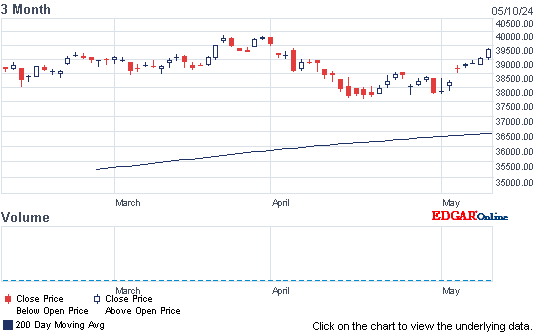Dow fell 86, declimners over advancers about 3-2 & NAZ lost 13. The MLP index was off pennies in the 319s & the REIT index was flat in the 355s. Junk bond funds did little & Treasuries went higher. Oil crawled higher in the 52s & gold slipped lower from recent highs.
AMJ (Alerian MLP Index tracking fund)

Factory Production in U.S. Falls Most Since August on Autos
Kansas City Fed Pres Esther George said she supports the continuation of the normalization of interest rates, even as she acknowledges it's unclear how markets will react to the Fed beginning to reduce its $4.5 T balance sheet. "It is difficult to know with a high degree of confidence just how the economy and financial markets will react once the FOMC announces and then takes steps to reduce the size of its securities holdings," she said. George says she would support beginning the process of reducing the balance sheet this year. George isn't a voting Federal Open Market Committee member until 2019.
Stocks are giving back some of yesterday's gains. The first earnings reports are coming in under expectations & intl tensions remain high. The North Korea mess is getting more attention because it can get very ugly, very fast. Dow continues to trend sideways under its recent high 6 week ago.
Dow Jones Industrials

AMJ (Alerian MLP Index tracking fund)
Output at US manufacturers fell in Mar by the most since Aug as production of automobiles & parts & business equipment declined, Federal Reserve data showed. Factory production dropped 0.4%, following a 0.3% rise in Feb (forecast called for unchanged). Total industrial production gained 0.5% on a record jump in utility output (forecast called for 0.5% rise). Capacity utilization, which measures the amount of a plant that is in use, rose to 76.1% from 75.7% in the prior month (forecast called for 76.1%). The weakness in auto manufacturing mirrors a slowdown in sales to consumers, indicating that a broader recovery at factories remains bumpy, with production rising 0.8% last month from a year earlier. The rebound in utility output follows 2 months of sharp declines amid unusually warm weather & may reflect stronger demand for heating with Mar temperatures that were a bit more seasonal. Utility output rose 8.6%, the most in data going back to 1939, after a 5.8% drop the previous month. Production of motor vehicles fell 3%, the most since last May. Excluding autos & parts, industrial production increased 0.8% after no change. Manufacturing output excluding vehicles & parts dropped 0.2% in Mar after a 0.3 percent gain a month earlier & a 0.5% jump in Jan. Oil and gas well drilling rose 7.7. Production of non-energy materials fell 0.6% after a 0.7% gain. Production of nondurable consumer goods rose 2.1%, while output of business equipment decreased 0.4%, the most since Aug.
Factory Production in U.S. Falls Most Since August on Autos
New-home construction in the US cooled in Mar to a 4-month low as starts of single-family properties settled back from the strongest pace in almost a decade, Commerce Dept data showed. Residential starts decreased 6.8% to a 1.22M annualized rate from a 1.3M in Feb. The forecast was for a 1.25M rate & Feb data was revised from 1.29M. Permits, a proxy for future construction, climbed 3.6% to a 1.26M annualized rate in Mar. The construction data are volatile from month to month, made worse in this report by changing weather as the unusually warm Feb that boosted totals during that month gave way to a more seasonal Mar. Fundamentally, there’s evidence of a strong outlook for the housing industry as homebuilder sentiment holds near the strongest level in more than a decade & mortgage rates have eased from their post-election high. Builders are still contending with labor & lot shortages as they struggle to keep up with solid demand stemming from a strengthening labor market. Construction of single-family houses declined 6.2% to an 821K rate from 875K in Feb (the strongest since Oct 2007). Groundbreaking on multifamily homes, such as townhouses & apartment buildings, decreased 7.9% to an annual rate of 394K in Mar, a 4-month low. Starts dropped in three of 4 regions, led by a 16.2% slump in the Midwest to a 6-month low & a 16% decline in the West. Completions of single-family dwellings increased to an 819K annual rate, the most since Sep 2008.
Kansas City Fed Pres Esther George said she supports the continuation of the normalization of interest rates, even as she acknowledges it's unclear how markets will react to the Fed beginning to reduce its $4.5 T balance sheet. "It is difficult to know with a high degree of confidence just how the economy and financial markets will react once the FOMC announces and then takes steps to reduce the size of its securities holdings," she said. George says she would support beginning the process of reducing the balance sheet this year. George isn't a voting Federal Open Market Committee member until 2019.
Fed's George Says She's Not Sure How Markets Will React To Balance Sheet Reduction
Stocks are giving back some of yesterday's gains. The first earnings reports are coming in under expectations & intl tensions remain high. The North Korea mess is getting more attention because it can get very ugly, very fast. Dow continues to trend sideways under its recent high 6 week ago.
Dow Jones Industrials













No comments:
Post a Comment